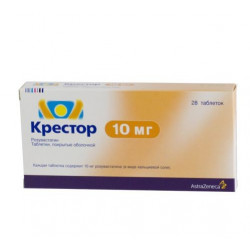



 All payments are encrypted via SSL
All payments are encrypted via SSL
 Full Refund if you haven't received your order
Full Refund if you haven't received your order
/Crustor
Crestor - tablets: 1 tab. contains Rosuvastatin (in the form of rosuvastatin calcium) 10, 20 and 40 mg
excipients: lactose monohydrate; MCC; Calcium phosphate; crospovidone; Magnesium stearate; hypromellose; glycerol triacetate; titanium dioxide (E171); iron oxide red (E172); purified water;
in a blister of 7 pcs., in a cardboard box 1 blister; or in a blister of 14 pcs., in a carton pack 2 blisters (10 mg and 20 mg);
in blister 7 pcs., in a carton pack of 1 or 4 blisters (40 mg).
Crestor has a lipid-lowering effect.
- primary hypercholesterolemia (type IIa, including familial heterozygous hypercholesterolemia) or mixed hypercholesterolemia (type IIb) as a supplement to the diet when diet and other non-drug therapies (eg exercise, weight loss) are insufficient;
- familial homozygous hypercholesterolemia as an adjunct to diet and other cholesterol-lowering therapy or in cases when such therapy is not suitable for the patient.
- liver diseases in the active phase, including a persistent increase in serum transaminase activity and any increase in serum transaminase activity (more than 3 times as compared with VGN);
- pronounced impaired renal function (CC <30 ml / min);
- myopathy;
- simultaneous administration of cyclosporine;
- pregnancy;
- lactation period (breastfeeding);
- lack of adequate methods of contraception;
- predisposition to the development of myotoxic complications;
- Hypersensitivity to rosuvastatin or any of the components of the Crestor.
Estimation of the frequency of adverse reactions: often (> 1%, <10%), sometimes (> 0.1%, <1%), rarely (> 0.01%, <0.1%), very rarely (<0.01%).
Allergic reactions: sometimes - urticaria; rarely - angioedema.
From the side of the central nervous system and peripheral nervous system: often - headache, dizziness; very rarely - polyneuropathy.
On the part of the digestive system: often - constipation, nausea, abdominal pain; rarely, a slight, asymptomatic, transient increase in liver transaminase activity; very rarely - jaundice, hepatitis.
Dermatological reactions: sometimes - itching, rash.
From the musculoskeletal system: often - myalgia; rarely - myopathy, rhabdomyolysis, arthralgia. A dose-dependent increase in CPK is observed in a small number of patients taking rosuvastatin. In most cases, it was minor, asymptomatic and temporary. In case of increase in CK more than 5 times higher than VGN therapy should be suspended.
On the part of the urinary system: proteinuria (<1% of patients receiving a dose of 10-20 mg and about 3% of patients receiving a dose of 40 mg).In most cases, proteinuria diminishes or disappears during therapy and does not mean the onset or the progression of an existing kidney disease.
Other: often - asthenic syndrome.
The side effects observed when taking Crestor are usually mild and do not go away on their own.
As with the use of other inhibitors of HMG-CoA reductase, the frequency of side effects is dose-dependent.
Crestor is taken orally, completely, without chewing, with water, at any time of the day, regardless of the meal. Treatment with Crestor should always be started with a dose of 10 mg both in patients who have not previously received statins, and when transferring from other drugs in this group. In most patients, a therapeutic effect is achieved when taking 10 mg of rosuvastatin. If necessary, the dose of Crestor can be increased to 20 mg after 4 weeks. Increasing the dose to 40 mg can be carried out only in patients with severe hypercholesterolemia with a high risk of cardiovascular complications (especially in patients with familial hypercholesterolemia) who do not achieve the desired result of therapy when taking a dose of 20 mg and which will be under the supervision of a physician.
In a dry place, at a temperature not higher than 20 ° C. Shelf life - 3 years.
